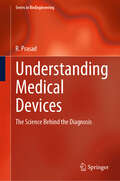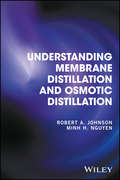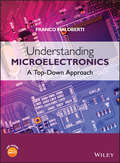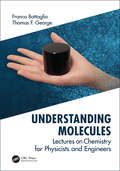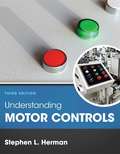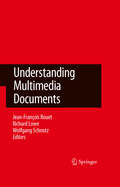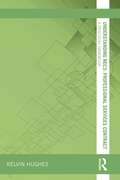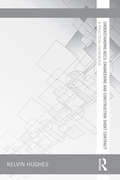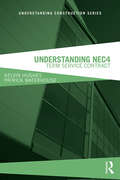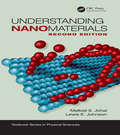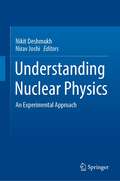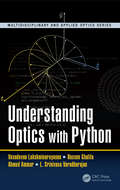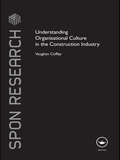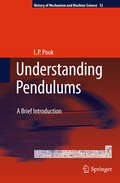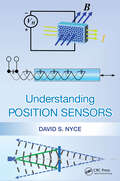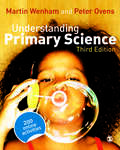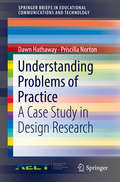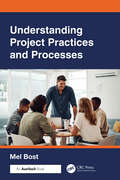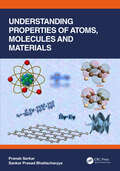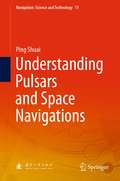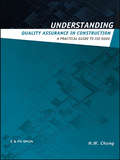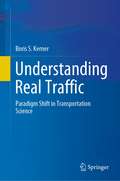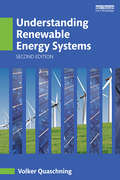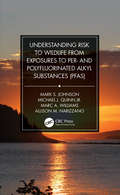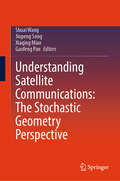- Table View
- List View
Understanding Medical Devices: The Science Behind the Diagnosis (Series in BioEngineering)
by R. PrasadThis book provides an accessible and comprehensive exploration of the principles and mechanisms behind widely used medical diagnostic tools. Written in clear, simple language, it offers a deep understanding of these instruments, their functionality, and the underlying science, making it ideal for a broad audience, including medical professionals, educators, and curious readers. The book begins with foundational concepts such as electromagnetic radiation, analog and digital signals, and binary systems, before diving into detailed discussions of key diagnostic tools like the stethoscope, thermometer, and pulse oximeter. Advanced imaging technologies such as X-rays, CT scans, MRI, and PET scans are thoroughly explained, along with non-invasive tools like ultrasound scanners and glucometers. Each chapter emphasizes the real-world applications and significance of these devices, with simple explanations supported by illustrative examples and figures. Designed for mixed readership, this book provides insights into the science behind diagnostic tools while also fostering a deeper appreciation for their practical impact on healthcare.
Understanding Membrane Distillation and Osmotic Distillation
by Robert A. Johnson Minh H. NguyenThis book addresses principles and practical applications of membrane distillation and osmotic distillation, separation technologies which are gaining increasing attention due to their advantages over conventional concentration processes.• Addresses membrane and osmotic distillation, two closely related and novel processes that offer several advantages over conventional concentration processes• Has a widespread impact and application of the technology in industries such as food, environment, and nuclear clean-up / containment• Covers theoretical aspects of both processes, the properties of hydrophobic membranes, process economics, integrated processes and future prospects.• Caters the presentation caters for the diversity of readership with respect to links with membrane technologies.
Understanding Microelectronics
by Franco MalobertiThe microelectronics evolution has given rise to many modern benefits but has also changed design methods and attitudes to learning. Technology advancements shifted focus from simple circuits to complex systems with major attention to high-level descriptions. The design methods moved from a bottom-up to a top-down approach.For today's students, the most beneficial approach to learning is this top-down method that demonstrates a global view of electronics before going into specifics. Franco Maloberti uses this approach to explain the fundamentals of electronics, such as processing functions, signals and their properties. Here he presents a helpful balance of theory, examples, and verification of results, while keeping mathematics and signal processing theory to a minimum.Key features:Presents a new learning approach that will greatly improve students' ability to retain key concepts in electronics studiesMatch the evolution of Computer Aided Design (CAD) which focuses increasingly on high-level designCovers sub-functions as well as basic circuits and basic componentsProvides real-world examples to inspire a thorough understanding of global issues, before going into the detail of components and devicesDiscusses power conversion and management; an important area that is missing in other books on the subjectEnd-of-chapter problems and self-training sections support the reader in exploring systems and understanding them at increasing levels of complexity A supporting website (http://www.wiley.com/WileyCDA/WileyTitle/productCd-047074555X,descCd-relatedWebsites.html) presents the interactive student lab, ElvisLAB, where students can conduct virtual experiments on circuits together with PowerPoint slides for lecturers.Inside this book you will find a complete explanation of electronics that can be applied across a range of disciplines including electrical engineering and physics. This comprehensive introduction will be of benefit to students studying electronics, as well as their lecturers and professors. Postgraduate engineers, those in vocational training, and design and application engineers will also find this book useful.
Understanding Molecules: Lectures on Chemistry for Physicists and Engineers
by Thomas F. George Franco BattagliaChemistry is a subject that many students with differing goals have to tackle. This unique general chemistry textbook is tailored to more mathematically-oriented engineering or physics students. The authors emphasize the principles underlying chemistry rather than chemistry itself and the almost encyclopedic completeness appearing in a common textbook of general chemistry is sacrificed for an emphasis to these principles. Contained within 300 pages, it is suitable for a one-semester course for students who have a strong background in calculus. Over 200 problems with answers are provided so that the students can check their progress.
Understanding Motor Controls
by Stephen L. HermanUsing a real-world systems approach to learning motor control devices, UNDERSTANDING MOTOR CONTROLS, 3rd Edition teaches you to install, troubleshoot, and test electrical motors like the pros! Starting with basic control circuits and components, this book covers all must-know applications and procedures to ensure your success in the more complex topics. From safety and development to operations and problem solving, UNDERSTANDING MOTOR CONTROLS prepares you for a career as an industrial electrician with a strong foundation in basic control circuits, sensing devices, solid-state controls, variable speed drives, programmable logic controllers (PLCs), and more. In addition, hands-on lab experiments give you practice putting what you learn into real-world practice.
Understanding Multimedia Documents
by Richard Lowe Jean-Francois Rouet Wolfgang SchnotzProfessionals who use multimedia documents as a tool to communicate concepts will find this a hugely illuminating text. It provides a comprehensive and up to date account of relevant research issues, methodologies and results in the area of multimedia comprehension. More specifically, the book draws connections between cognitive research, instructional strategies and design methodologies. It includes theoretical reviews, discussions of research techniques, ad original experimental contributions. The book highlights essential aspects of current theories, and trends for future research on the use of multimedia documents.
Understanding NEC3: A Practical Handbook (Understanding Construction)
by Kelvin HughesAs use of the NEC (formerly the New Engineering Contract) family of contracts continues to grow worldwide, so does the importance of understanding its clauses and nuances to everyone working in the built environment. Currently in its third edition, this set of contracts is different to others in concept as well as format, so users may well find themselves needing a helping hand along the way. Understanding NEC3: Professional Services Contract uses plain English to lead the reader through the NEC3 Professional Services Contract’s key features, including: Main and Secondary Options the use of early warnings programme provisions payment compensation events preparing and assessing tenders. Common problems experienced when using the Professional Services Contract are signalled to the reader throughout, and the correct way of reading each clause is explained. The ways in which the contract affects procurement processes, dispute resolution, project management and risk management are all addressed in order to direct the user to best practice. Written for construction professionals, by a practising international construction contract consultant, this handbook is the most straightforward, balanced and practical guide to the NEC3 PSC available. It is an ideal companion for Employers, Consultants, Contractors, Engineers, Architects, Quantity Surveyors, Subcontractors and anyone else interested in working successfully with the NEC3 PSC.
Understanding NEC3: A Practical Handbook (Understanding Construction)
by Kelvin HughesAs usage of the NEC (formerly the New Engineering Contract) family of contracts continues to grow worldwide, so does the importance of understanding its clauses and nuances to everyone working in the built environment. This set of contracts, currently in the third edition, is different to others in concept as well as format, so users may well find themselves needing a helping hand along the way. Understanding the NEC3 Engineering and Construction Short Contract uses plain English to lead the reader through the contract’s key features, including: the use of early warnings programme provisions payment compensation events preparing and assessing tenders Common problems are signalled to the reader throughout, and the correct way of reading each clause explained. In addition, the things to consider when deciding between the ECSC and the longer Engineering and Construction Contract are discussed in detail. Written for professionals without legal backgrounds, by a practicing construction contract consultant, this handbook is the most straightforward, balanced and practical guide to the NEC3 ECSC available. An ideal companion for Employers, Contractors, Project Managers, Supervisors, Engineers, Architects, Quantity Surveyors, Subcontractors, and anyone else interested in working successfully with the NEC3 ECSC.
Understanding NEC4: Term Service Contract (Understanding Construction)
by Kelvin Hughes Patrick WaterhouseWith the release of the new NEC (formerly the New Engineering Contract), the use of the family of contracts continues to grow worldwide, as does the importance of understanding its clauses and nuances to everyone working in the built environment. Now in its fourth edition, this set of contracts is different to others in concept as well as format, so users may well find themselves needing a helping hand along the way. Written in plain English, Understanding NEC4: Term Service Contract offers a practical guide to the use and management of the NEC4 Term Service Contract (TSC). The authors describe the full life of a contract, from the initial selection of options and contract formation through to the operations period and ultimately termination and dispute resolution. Although born of the same stable as the NEC4 construction contracts, the TSC is aimed at maintaining infrastructure and differs significantly from its siblings. This is the first book to be written on the new contract and takes the reader through the important provisions including communications, planning, early warnings, compensation events and payments. It is ideal for clients, contractors and their advisors describing how to deploy the contract successfully.
Understanding Nanomaterials, Second Edition (Textbook Series in Physical Sciences)
by Malkiat S. Johal Lewis E. JohnsonPraise for the first edition"clear and informative” ?Chemistry World The authors provide the perfect training tool for the workforce in nanotech development by presenting the fundamental principles that govern the fabrication, characterization, and application of nanomaterials. This edition represents a complete overhaul, giving a much more complete, self-contained introduction. As before, the text avoids excessive mathematical detail and is written in an easy to follow, appealing style suitable for anyone, regardless of background in physics, chemistry, engineering, or biology. The organization has been revised to include fundamental physical chemistry and physics pertaining to relevant electrical, mechanical, and optical material properties. Incorporates new and expanded content on hard materials, semiconductors for nanoelectronics, and nonlinear optical materials. Adds many more worked examples and end-of-chapter problems. Provides more complete coverage of fundamentals including relevant aspects of thermodynamics, kinetics, quantum mechanics, and solid-state physics, and also significantly expands treatment of solid-phase systems. Malkiat S. Johal is a professor of physical chemistry at Pomona College, and earned his doctorate in physical chemistry at the University of Cambridge, UK. Lewis E. Johnson is a research scientist at the University of Washington, where he also earned his doctorate in chemistry and nanotechnology.
Understanding Nuclear Physics: An Experimental Approach
by Nirav Joshi Nikit DeshmukhThis book provides a unique approach to understand the Nuclear Physics, especially from the experimental end. The highlight of this book is that special care has been taken to provide more experimental information, considering real experimental data which has been published in several journals. Special experimental focus is given to methodologies involving: offline gamma counting and online particle detection. The book provides information about recent developments in accelerators, overview of the detectors and concise information of associated electronics, data acquisition systems and computers for data analysis.
Understanding Optics with Python (Multidisciplinary and Applied Optics)
by Ahmed Ammar Vasudevan Lakshminarayanan Hassen Ghalila L. VaradharajanOptics is an enabling science that forms a basis for our technological civilization. Courses in optics are a required part of the engineering or physics undergraduate curriculum in many universities worldwide. The aim of Understanding Optics with Python is twofold: first, to describe certain basic ideas of classical physical and geometric optics; second, to introduce the reader to computer simulations of physical phenomena. The text is aimed more broadly for those who wish to use numerical/computational modeling as an educational tool that promotes interactive teaching (and learning). In addition, it offers an alternative to developing countries where the necessary equipment to carry out the appropriate experiments is not available as a result of financial constraints. This approach contributes to a better diffusion of knowledge about optics. The examples given in this book are comparable to those found in standard textbooks on optics and are suitable for self-study. This text enables the user to study and understand optics using hands-on simulations with Python. Python is our programming language of choice because of its open-source availability, extensive functionality, and an enormous online support. Essentials of programming in Python 3.x, including graphical user interface, are also provided. The codes in the book are available for download on the book’s website. Discusses most standard topics of traditional physical and geometrical optics through Python and PyQt5 Provides visualizations and in-depth descriptions of Python’s programming language and simulations Includes simulated laboratories where students are provided a "hands-on" exploration of Python software Coding and programming featured within the text are available for download on the book’s corresponding website. "Understanding Optics with Python by Vasudevan Lakshminarayanan, Hassen Ghalila, Ahmed Ammar, and L. Srinivasa Varadharajan is born around a nice idea: using simulations to provide the students with a powerful tool to understand and master optical phenomena. The choice of the Python language is perfectly matched with the overall goal of the book, as the Python language provides a completely free and easy-to-learn platform with huge cross-platform compatibility, where the reader of the book can conduct his or her own numerical experiments to learn faster and better."— Costantino De Angelis, University of Brescia, Italy "Teaching an important programming language like Python through concrete examples from optics is a natural and, in my view, very effective approach. I believe that this book will be used by students and appreciated greatly by instructors. The topic of modelling optical effects and systems where the students should already have a physical background provides great motivation for students to learn the basics of a powerful programming language without the intimidation factor that often goes with a formal computer science course." — John Dudley, FEMTO-ST Institute, Besançon, France
Understanding Organisational Culture in the Construction Industry (Spon Research)
by Vaughan CoffeySince the early 1980s, researchers and practitioners in the organisational and management fields have presumed a link between organisational, or corporate, culture and organisational performance. Whilst many believe this exists, other authors have been critical of the validity of such studies. Part of this doubt stems from a reliance on measures of organisational performance that are based purely on financial measures of business growth. Using the construction industry as the subject of his research, Vaughan Coffey traces the development of the literature on organisational culture and business effectiveness and investigates the culture-performance link using a new and highly objective measure of company performance and an evaluation of organisational culture, which is largely behaviourally-based. Providing a theoretical contribution to the field, this work shows that various cultural traits appear to be closely linked to objectively measured organisational effectiveness. This book will be valuable to professionals and researchers in the fields of management and public policy. It indicates directions for construction companies to develop and change, and in doing so strengthen their chances of remaining strong when opportunities for work might deplete and only the most successful companies will be able to survive.
Understanding Pendulums
by L. P. PookDespite their apparent simplicity, the behaviour of pendulums can be remarkably complicated. Historically, pendulums for specific purposes have been developed using a combination of simplified theory and trial and error. There do not appear to be any introductory books on pendulums, written at an intermediate level, and covering a wide range of topics. This book aims to fill the gap. It is written for readers with some background in elementary geometry, algebra, trigonometry and calculus. Historical information, where available and useful for the understanding of various types of pendulum and their applications, is included. Perhaps the best known use of pendulums is as the basis of clocks in which a pendulum controls the rate at which the clock runs. Interest in theoretical and practical aspects of pendulums, as applied to clocks, goes back more than four centuries. The concept of simple pendulums, which are idealised versions of real pendulums is introduced. The application of pendulums to clocks is described, with detailed discussion of the effect of inevitable differences between real pendulums and simple pendulums. In a clock, the objective is to ensure that the pendulum controls the timekeeping. However, pendulums are sometimes driven, and how this affects their behaviour is described. Pendulums are sometimes used for occult purposes. It is possible to explain some apparently occult results by using modern pendulum theory. For example, why a ring suspended inside a wine glass, by a thread from a finger, eventually strikes the glass. Pendulums have a wide range of uses in scientific instruments, engineering, and entertainment. Some examples are given as case studies.
Understanding Position Sensors
by David NyceAs the definitive resource on position sensing technology, Understanding Position Sensors encompasses all aspects necessary for a full understanding of the field, with topics of background, operational theory, design, and application. While grasping the theory of technologies used in the measurement of linear and angular/rotary position sensors, the reader will also learn about terminology, interfacing, testing, and other valuable concepts that are useful in the understanding of sensors in general. The first three chapters provide readers with the necessary background information on sensors. These chapters review the working definitions and conventions used in sensing technology; specification of position sensors and the effect on performance; and sensor output types, plus an extensive section covering communication protocols. The remaining chapters describe each separate sensor technology in detail. These include resistive sensors, cable extension transducers, capacitive sensors, inductive sensors, LVDT and RVDT sensors, distributed impedance sensors, Hall effect sensors, magnetoresistive sensors, magnetostrictive sensors, linear and rotary encoders, optical triangulation position sensors, and ultrasonic position sensors. Presents sensor specification, theory of operation, sensor design, and application criteria Reviews the background history of position sensors as well as the underlying engineering techniques Includes end-of-chapter exercises Understanding Position Sensors is written for electrical, mechanical, and material engineers, as well as for engineering students who are interested in understanding sensor technologies, and can be used as a textbook for an engineering course on sensor technology.
Understanding Primary Science (Routledge Revivals Ser.)
by Matin Wenham Peter OvensNow in its third edition, this text provides the background knowledge primary teachers need to plan effective programmes of work and answer children's questions with confidence. The new edition links explanations of scientific concepts with children's everyday experiences to help teachers and trainees foresee how they will present the subject knowledge to their pupils. Shaped by the National Curriculum, this text explains key scientific theories and concepts which pupils at primary level, including very able children, need in order to understand the observations and investigations they undertake. A CD Rom of 200 science investigations for young students is included with the new edition, allowing teachers to explore the practical application of topics covered in the book. This is an essential book for teachers, student teachers and anyone interested in the roots and growth of science education.
Understanding Problems of Practice: A Case Study In Design Research (Springerbriefs In Educational Communications And Technology Ser.)
by Dawn Hathaway Priscilla NortonToday, K-12 practitioners are challenged to become educational innovators. Yet, little is available to the practitioner to guide their reflection about the design, development, and implementation of these innovations in their own practice. This brief approaches such problems of practice from the perspectives of design research. Although design research typically centers on the partnership between researchers and practitioners in real-world settings, relationships between researchers and practitioners are not always practical. In this brief, the authors explore how the design research process can make the goals, assumptions, processes, methods, and outcomes of design research uniquely accessible to the practitioner. In clear, explicit language, it introduces design research to practitioners using both expository discussions and a robust narrative case study approach that ably guides the reader through the phases of design research, namely:Theory to innovation to practiceUnderstanding problems of practiceCreating a design solutionAssessing the design solutionEvaluating learning outcomesCapturing lessons for practiceUnderstanding Problems of Practice is a singular resource for teachers and practitioners enrolled in graduate research courses or courses on teacher leadership. It also lends itself well as a supplement to professional development activities and studies at the district, school, and professional learning community levels.
Understanding Project Practices and Processes
by Mel BostUnderstanding Project Practices and Processes distills the author’s experiences in developing program management offices (PMOs) and as an IT project office to guide project managers who may be facing challenges in delivering project goals and managing teams and stakeholders. With insights into the behavior of project teams, project managers, stakeholders, and project organizations, the book brings to life such processes and practices of project management as risk management, innovation, and design thinking.In presenting principles dedicated to achieving successfully good, sound business and technological maturity, the book explains the following: Using lessons learned to improve processes. When to implement process improvement to better attain goals. Process capability maturity as a continuous process of improving and maturing a process to achieve consistent and repeatable results. Distinction between processes and projects. How projects turn a strategy into action. Key roles of communications and technology. Research and real-world scenarios explain the practice of project management. With in-depth coverage of project management offices, knowledge management, change management, and project best practices, this book is an indispensable guide for new, as well as veteran, project managers.
Understanding Properties of Atoms, Molecules and Materials
by Sankar Prasad Bhattacharyya Pranab SarkarIn a technology driven civilization the quest for new and smarter materials is everlasting. They are required as platforms for developing new technologies or for improving an already existing technology. The discovery of a new material is no longer chance driven or accidental, but is based on careful reasoning structured by deep understanding of the microconstituents of materials - the atoms and molecules in isolation or in an assembly. That requires fair amount of exposure to quantum and statistical mechanics. `Understanding Properties of Atoms, Molecules and Materials' is an effort (perhaps the first ever) to bring all the necessary theoretical ingredients and relevant physical information in a single volume. The book introduces the readers (first year graduates) or researchers in material chemistry/engineering to elementary quantum mechanics of atoms, molecules and solids and then goes on to make them acquainted with methods of statistical mechanics (classical as well as quantum) along with elementary principles of classical MD simulation. The basic concepts are introduced with clarity and illustrated with easy to grasp examples, thus preparing the readers for an exploration through the world of materials - the exotic and the mundane. The emphasis has been on the phenomena and what shapes them at the fundamental level. A comprehensive description of modern designing principles for materials with examples is a unique feature of the book. The highlights of the book are comprehensive introduction and analysis of Quantum states of atoms and molecules The translational symmetry and quantum states in periodic and amorphous solids Band structure and tuning Classical and quantum statistics with applications to ideal gases (photons, phonons and electrons, molecules) Quantum states in type-I and type-II superconductors (elementary theory included) Magnetic materials, materials with GMR and CMR Shape memory effects in alloys and materials 2D materials (graphene and graphene analogus) NLO and photovoltaic materials Hydrogen storage material for mitigating the looming energy crisis Quantum states in low and high band gap semiconductors Semimetals Designer materials, etc. The volume is designed and organized to create interest in the science of materials and the silent revolution that is redefining the goals and boundaries of materials science continuously.
Understanding Pulsars and Space Navigations (Navigation: Science and Technology #11)
by Ping ShuaiThis book systematically presents the concept, history, implementation, theory system and basic methods of pulsar and space flight, illustrating the characteristics of pulsars. It also describes the classification of spacecraft navigation systems and the autonomous navigation technologies, as well as X-ray pulsar-based navigation systems (XPNAV) and discusses future navigation satellite systems in detail.
Understanding Quality Assurance in Construction: A Practical Guide to ISO 9000 for Contractors (Understanding Construction)
by H.W. ChungThe ISO 9000 family of quality standards has been adopted world-wide as a framework for building better relationships between suppliers and customers. Originally a manufacturing-industry concern, quality is now acknowledged to be a key issue for the construction sector whose clients increasingly demand quality certification. This book explains the concepts and practice of quality assurance and management in construction. Clearly written and well illustrated, with plenty of sample quality system documents and other pro-forma, this book will make the daunting task of developing, implementing and managing a quality system a great deal easier for contractors.This is practical guide for building and construction contractors and sub-contractors, project managers and other construction professionals. Also for undergraduate and postgraduate students of building, construction management and project management.
Understanding Real Traffic: Paradigm Shift in Transportation Science
by Boris S. KernerThis book addresses the reader interested in vehicular traffic phenomena, who have not learned about them before. It presents traffic phenomena like traffic breakdown and the emergence of moving traffic jams by showcasing empirical traffic data measured in real-world traffic. The author explains how these empirical traffic studies have led to the three-phase traffic theory and why this new theory is in conflict with standard traffic theories developed before. Moreover, he presents the reason for the failure of applications of standard traffic theories in real-world traffic and discusses why understanding real traffic has caused a paradigm shift in traffic and transportation science. The book examines why understanding real traffic breakdown is the basis for an explanation for the autonomous driving effects on traffic flow. It shows that understanding real traffic is possible from real-world traffic data without the need of mathematical traffic models. This makes the book intuitive for non-specialists, who can qualitatively understand all the basic features of traffic dynamics. In turn, experienced traffic researchers can grasp concepts and ideas made here easily accessible by the author, one of the leading pioneers in the field of vehicular traffic.
Understanding Renewable Energy Systems
by Volker QuaschningBy mid-century, renewable energy must cover all of our energy supply if we are to phase out nuclear and successfully stop climate change. Now updated and expanded, the 2nd edition of this textbook covers the full range of renewable energy systems and now also includes such current trends as solar power storage, power-to-gas technologies, and the technology paths needed for a successful and complete energy transition. The topics are treated in a holistic manner, bringing together maths, engineering, climate studies and economics, and enabling readers to gain a broad understanding of renewable energy technologies and their potential.Numerous examples are provided for calculations, and graphics help visualize the various technologies and mathematical methodologies. Understanding Renewable Energy Systems is an ideal companion for students of renewable energy at universities or technical colleges on courses such as renewable energy, electrical engineering, engineering technology, physics, process engineering, building engineering, environment, applied mechanics and mechanical engineering, as well as scientists and engineers in research and industry.
Understanding Risk to Wildlife from Exposures to Per- and Polyfluorinated Alkyl Substances (PFAS)
by Mark S. Johnson Michael J. Quinn Jr. Marc A. Williams Allison M. NarizzanoUnderstanding Risk to Wildlife from Exposures to Per- and Polyfluorinated Alkyl Substances (PFAS) provides the most recent summary of toxicity data relevant to mammals, birds, reptiles, and amphibians, and provides values for use in risk assessment applications. Predicting the bioaccumulation of PFAS in terrestrial wildlife (including humans) has proven to be extremely complex. As a group, PFAS act differently than traditional non-ionic organic molecules, where PFAS can break down and reform, whereas some are demonstrated to be extremely persistent. Where sufficient data are provided, this book establishes toxicity reference values (TRVs), which are derived to assist in characterizing environmental sources of contamination and making risk-based decisions. Features: Provides toxicity reference values (TRVs) for vertebrates (mammals, birds, amphibians) for PFAS, where sufficient data are available, and includes objective supporting background information. Assigns a level of confidence to each TRV to provide the risk assessor with an understanding of the relative uncertainty associated with each value. Presents toxicity data in the formats of scatter diagrams and tables for quick review and assessment. Provides TRVs relevant for screening and decision making This book serves as a useful aid for risk assessors and managers in those industries that have sites contaminated with PFAS, consultants tasked with evaluating risks at such sites, and staff at regulatory agencies at various governmental levels, who need to know how much contamination is considered safe for wildlife. It will also appeal to researchers with an interest in filling the gaps in the current toxicological data for PFAS exposure.
Understanding Satellite Communications: The Stochastic Geometry Perspective
by Shuai Wang Gaofeng Pan Xiaqing Miao Jinpeng SongThis book aims to analyze and model satellite communication systems while taking into account the variable transmission performance that occurs due to randomness in space, aerial, and terrestrial terminals. The book covers both conceptual principles and practical engineering applications, with an emphasis on the latter. Readers will gain a deep understanding of several major topics, including satellite-terrestrial communications, satellite-aerial communications, satellite-aerial-terrestrial communications, and terrestrial-satellite-terrestrial communications. A key feature of this book is its comprehensive and systematic treatment of satellite communication issues, making it an ideal resource for anyone interested in learning about various application scenarios in this field. Researchers, engineers, and graduate students in wireless communications, signal processing, and related areas will find this book highly valuable.
